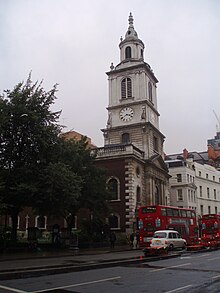St Botolph-without-Bishopsgate
| St. Botolph-without-Bishopsgate | |
|---|---|

Exterior photo of St. Botolph-without-Bishopsgate
|
|
| Country | United Kingdom |
| Denomination | Church of England and Antiochian Orthodox Church |
| Architecture | |
| Heritage designation | Grade II* |
| Administration | |
| Diocese | London |
| Clergy | |
| Rector | Alan McCormack |
St Botolph-without-Bishopsgate is a Church of England church on the west side of Bishopsgate in the City of London, first mentioned in 1212. It survived the Great Fire of London in 1666, and was rebuilt in 1724–29.
The church is on the west side of Bishopsgate near Liverpool Street station. In the Middle Ages the site was just outside the city walls near the "Bishop's Gate" after which the street is named. St Botolph was a patron saint of travellers, so it was an appropriate dedication for a church near a city gate. There were three other churches of St Botolph in medieval London, at Billingsgate, Aldgate and Aldersgate.
Adjoining the buildings is a substantial churchyard – running along the back of Wormwood Street, the former course of London Wall – and a former school. The church is linked with the Worshipful Company of Coopers and the Worshipful Company of Bowyers.
Christian worship on this site may have Roman origins, though this is not fully proven. Stow, writing in 1598 only describes the church of his time as standing "in a fair churchyard, adjoining to the town ditch, upon the very bank thereof". It narrowly escaped the Great Fire, the sexton's house having been partly demolished to stop the spread of the flames. Writing in 1708, Hatton described it as "an old church built of brick and stone, and rendered over". By this time the Gothic church had been altered with the addition of Tuscan columns supporting the roof, and Ionic ones the galleries.
In 1710, the parishioners petitioned parliament for permission to rebuild the church on another site, but nothing was done. In 1723 the church was found to be irreparable and the parishioners petitioned again.Having obtained an act of Parliament, they set up a temporary building in the churchyard, and began to rebuild the church. The first stone was laid in 1725, and the new building was consecrated in 1728, though not completed until the next year. The designer was James Gold. or Gould. During construction, the foundations of the original Anglo-Saxon church were discovered.
...
Wikipedia
